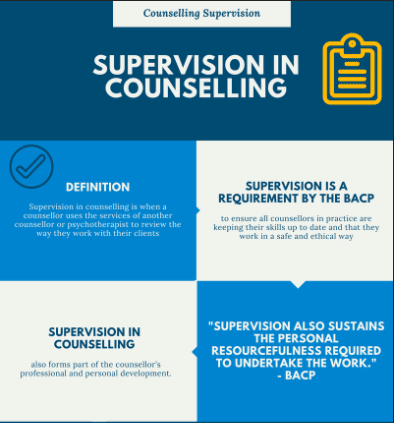Supervision in Counselling
Supervision in counselling is when a counsellor uses the services of another counsellor or psychotherapist to review the way they work with their clients. Supervision is a requirement by the BACP to ensure all counsellors in practice are keeping their skills up to date and that they work in a safe and ethical way. Supervision in counselling also forms part of the counsellor’s professional and personal development.
Supervision in counselling is an important part of working to professional standards. As such, it is required by the Ethical Framework for the Counselling Professions, published by the British Association for Counselling & Psychotherapy (BACP):
‘We will keep skills and knowledge up to date by … reviewing our knowledge and skills in supervision or discussion with experienced practitioners’ (paragraph 14b).
The BACP Ethical Framework goes on to provide a full section devoted to supervision, starting as follows (paragraph 50):

"Supervision is essential to how practitioners sustain good practice throughout their working life. Supervision provides practitioners with regular and ongoing opportunities to reflect in depth about all aspects of their practice in order to work as effectively, safely and ethically as possible. Supervision also sustains the personal resourcefulness required to undertake the work."
Managerial Supervision in Counselling
When counsellors talk about ‘supervision’, they usually mean clinical (also known as ‘casework’) supervision. There is also managerial supervision (also known as ‘internal supervision’ or ‘line management’) – this refers to the management that you receive in your counselling agency.
For example, your managerial supervisor:
- provides and monitors compliance with policies and procedures
- works to ensure counsellors’ safety in the building
- organises continuing professional development
- allocates clients to individual counsellors, and allocates rooms
- monitors and investigates the reasons for ‘Did Not Attend’ (DNA) rates.

Supervision provides practitioners with regular and ongoing opportunities to reflect in depth about all aspects of their practice in order to work as effectively, safely and ethically as possible.
Clinical supervision must be separate from managerial supervision and ideally from the organisation:
‘The independent nature of the consultant enables them to clearly separate themselves from line management and any other type of internal structures’ (Sanders, 2013: 330).
Dual relationships must also be avoided.
What Does Counselling Supervision Entail?
You might imagine that working with a counselling supervisor would be like having a yearly review with your boss: when you are given targets to achieve, told what training you must attend, and informed whether or not you get a pay rise.
However, counselling supervision is very different. A supervisor is a qualified counsellor, with additional qualifications in supervision and considerable practice experience.
As a student, you would typically see your supervisor for 1.5 hours after 12 hours of client work or after one month (depending on which comes first).
It is important to keep records of when you see your supervisor and for how long; without this, the client hours you have accumulated might not be counted by your awarding body.
3 Main areas of Supervision
Supervision falls into three main areas, with ethics always being in the forefront of both the supervisors and counsellors’ mind:
- Formative (i.e. growth-based): the supervisor shares their experience to teach the counsellor.
- Normative (i.e. monitoring-based): the supervisor asks the counsellor to account and justify their work.
- Restorative (i.e. support-based): the supervisor offers support if the counsellor is struggling with an ethical issue or an aspect of their practice.
Supervision is not the place for the counsellor to obtain their own therapy, although sometimes issues in a counsellor’s life might impact on their ability to give full attention to the client.
If this is the case, then the supervisor might suggest that the counsellor accesses their own therapy to look at issues in their lives.
Seven-Eyed Model of Supervision
Understanding models of supervision can help us get the best out of our supervision, informing what we take to our supervisor.
Having a common language can support us to work more cooperatively and collegially together.
One model that is used widely is that by Shohet and Hawkins, as described in their book Supervision in the Helping Professions (Open University Press, 2012).
This model is popular not only in counselling and psychotherapy but also in coaching, social work and support work.
The ‘seven eyes’ refer to seven different ways of looking at the client presentation and related relationships.
These focus on the:
- client
- supervisee’s interventions
- client–supervisee relationship
- supervisee’s own experiences
- supervisor–supervisee relationship
- supervisor’s own reflections
- wider context
Free Handout Download
Supervision Brief Overview
Types of Supervision in Counselling
Most supervision takes place on a one-to-one basis, but you can also have group supervision.
You can’t usually count all the time you spend in this.
For example, the BACP allows you to claim half the time if there are up to four people in the group.
For groups of more than four, you have to divide the amount of time by the number of people (so for two hours of supervision, a group of six could claim 20 minutes each).
Peer supervision again involves working in a group, but without the presence of a qualified supervisor.
Peer supervision is usually a reciprocal arrangement involving peers working together to help each other learn and develop.
When individuals lead their own supervision processes in this way, it can be difficult to maintain the quality and effectiveness over time, and so is often seen as supplement to – rather than substitute for – supervision with a qualified and experienced supervisor.